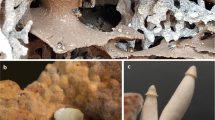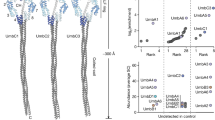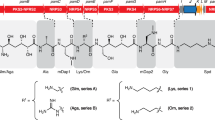Abstract
Fungus-growing ants engage in mutualistic associations with both the fungus they cultivate for food and actinobacteria (Pseudonocardia spp.) that produce selective antibiotics to defend that fungus from specialized fungal parasites. We have analyzed one such system at the molecular level and found that the bacterium associated with the ant Apterostigma dentigerum produces dentigerumycin, a cyclic depsipeptide with highly modified amino acids, to selectively inhibit the associated parasitic fungus (Escovopsis sp.).
This is a preview of subscription content, access via your institution
Access options
Subscribe to this journal
Receive 12 print issues and online access
$259.00 per year
only $21.58 per issue
Buy this article
- Purchase on Springer Link
- Instant access to full article PDF
Prices may be subject to local taxes which are calculated during checkout


Similar content being viewed by others
References
Currie, C.R., Scott, J.A., Summerbell, R.C. & Malloch, D. Nature 398, 701–704 (1999).
Scott, J.J. et al. Science 322, 63 (2008).
Bérdy, J. J. Antibiot. (Tokyo) 58, 1–26 (2005).
Kaltenpoth, M., Göttler, W., Herzner, G. & Strohm, E. Curr. Biol. 15, 475–479 (2005).
Schultz, T.R. & Brady, S.G. Proc. Natl. Acad. Sci. USA 105, 5435–5440 (2008).
Currie, C.R., Poulsen, M., Mendenhall, J., Boomsma, J.J. & Billen, J. Science 311, 81–83 (2006).
Reynolds, H.T. & Currie, C.R. Mycologia 96, 955–959 (2004).
Matsumori, N., Kaneno, D., Murata, M., Nakamura, H. & Tachibana, K. J. Org. Chem. 64, 866–876 (1999).
Miller, E.D., Kauffman, C.A., Jensen, P.R. & Fenical, W. J. Org. Chem. 72, 323–330 (2007).
Fujii, K. et al. Tetrahedron 58, 6873–6879 (2002).
Schultz, A.W. et al. J. Am. Chem. Soc. 130, 4507–4516 (2008).
Fujii, K., Ikai, Y., Oka, H., Suzuki, M. & Harada, K. Anal. Chem. 69, 5146–5151 (1997).
Seco, J.M., Quiñoá, E. & Riguera, R. Tetrahedron Asymmetry 12, 2915–2925 (2001).
Pennings, M.L.M., Reinhoudt, D.N., Harkema, S. & van Hummel, G.J. J. Org. Chem. 48, 486–491 (1983).
Snatzke, G., Wagner, U. & Wolff, H.P. Tetrahedron 37, 349–361 (1981).
Umezawa, K., Nakazawa, K., Ikeda, Y., Naganawa, H. & Kondo, S. J. Org. Chem. 64, 3034–3038 (1999).
Gräfe, U. et al. J. Antibiot. (Tokyo) 48, 119–125 (1995).
Fischbach, M.A., Walsh, C.T. & Clardy, J. Proc. Natl. Acad. Sci. USA 105, 4601–4608 (2008).
Oh, D.-C., Scott, J.J., Currie, C.R. & Clardy, J. Org. Lett. 11, 633–636 (2009).
Currie, C.R. et al. Science 299, 386–388 (2003).
Acknowledgements
We thank the Smithsonian Tropical Research Institute for providing facilities in which to work in Panama, the Autoridad Nacional del Ambiente y el Mar for sampling and export permits, J. Heemstra and C. Walsh (Harvard Medical School) for providing synthetic piperazic acids, and A. Adams, S. Marsh, A. Pinto-Tomas and G. Suen (University of Wisconsin–Madison) for comments on a manuscript draft. This work was supported by funding from the Lundbeck and Carlsberg Foundations to M.P., from the US National Science Foundation (MCB07020255) to C.R.C. and from the US National Institutes of Health (CA24487) to J.C.
Author information
Authors and Affiliations
Contributions
D.-C.O., M.P., C.R.C. and J.C. designed experiments and wrote the manuscript. D.-C.O. performed the structural determination and biological activity analysis on dentigerumycin. M.P. isolated the cultivar, the parasite and the Pseudonocardia symbionts and performed bioassay parings.
Corresponding authors
Supplementary information
Supplementary Text and Figures
Supplementary Figures 1–8, Supplementary Tables 1 and 2, and Supplementary Methods (PDF 1001 kb)
Rights and permissions
About this article
Cite this article
Oh, DC., Poulsen, M., Currie, C. et al. Dentigerumycin: a bacterial mediator of an ant-fungus symbiosis. Nat Chem Biol 5, 391–393 (2009). https://doi.org/10.1038/nchembio.159
Received:
Accepted:
Published:
Issue Date:
DOI: https://doi.org/10.1038/nchembio.159
This article is cited by
-
Identification of peptides from honeybee gut symbionts as potential antimicrobial agents against Melissococcus plutonius
Nature Communications (2023)
-
Ants/Nest-Associated Fungi and Their Specialized Metabolites: Taxonomy, Chemistry, and Bioactivity
Revista Brasileira de Farmacognosia (2023)
-
Uncovering the biodiversity and biosynthetic potentials of rare actinomycetes
Future Journal of Pharmaceutical Sciences (2022)
-
Community composition, bacterial symbionts, antibacterial and antioxidant activities of honeybee-associated fungi
BMC Microbiology (2022)
-
Pseudonocardia cytotoxica sp. nov., a novel actinomycete isolated from an Arctic fjord with potential to produce cytotoxic compound
Antonie van Leeuwenhoek (2021)



